
Kalalau Trail Travel Guide

The Na Pali Coast State Wilderness Park is one of the most surreal destinations in the world. The sapphire waters, dense jungle foliage, and dramatic coastal ridges unite along Kauai’s northwestern coast into a truly unique landscape. You’re able to view the coast via boat tours, but today we wanted to highlight the hiking journey known as the Kalalau Trail, which treks along the scenic natural wonder that is the Na Pali Coast.
Kalalau Trail Permits and Reservations
 View from the Kalalau Trail
View from the Kalalau Trail
The beginning of the Kalalau Trail is located in Ha'ena State Park. Before you hit the trail, you’ll need to secure either a Na Pali Coast Camping Permit (if you are backpacking overnight) or a Ha'ena State Park Entry Pass (if you are only hiking for the day). No one is allowed in the park without one or the other anymore.
Camping Permits
For those planning to backpack along the trail, camping permits are available three months in advance and usually fill about two months before a particular date, so be sure to secure your permit as early as possible. You can stay in the park for no more than 5 consecutive nights. Camping permits cost $35 per night for non residents.
Day Use Access
If you only plan to hike for the day, you'll need to reserve a Ha'ena State Park Entry Pass which is $5 per person. If you plan to drive to the park, you'll also need a separate parking reservation. Or you can take the shuttle. (See more below). You can make your reservations for Entry + Parking or Entry + Shuttle at Ha'ena State Park Access up to 30 days in advance.
Kalalau Parking and Shuttle
There is limited parking available for day hikers, and parking is even more competitive for overnight campers. You can try to secure overnight parking online after you have your camping permit. Alternatively, you may want to book a shuttle at Ha'ena State Park Access, which picks up at the Waipa Park & Ride on the corner of Kumu Road and Kuhio Highway in Hanalei. Parking or shuttle reservations are necessary if you plan on visiting the Kalalau Trail - even if just for the day.
- Make your Entry + Parking reservations or Entry + Shuttle reservations at Ha'ena State Park Access.
- For overnight parking information, click Ha'ena State Park - Camping & Overnight Parking.
- For more information about parking, fees, and the shuttle, click Ha'ena State Park - Info & FAQ's.
Restrooms
There are flush toilets at Ke'e Beach and portapotty-style toilets near Hanakapi'ai Beach.
The Kalalau Trail, Na Pali Coast Hike
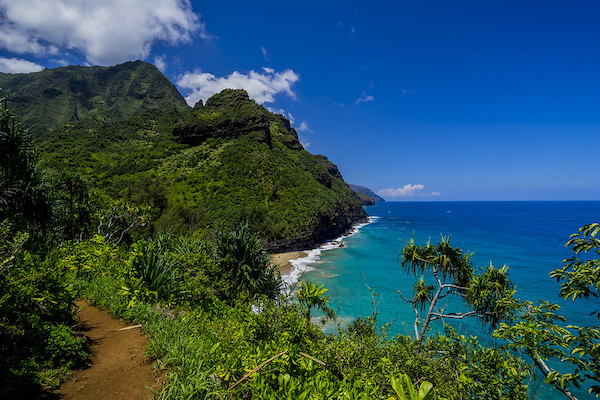
If you want to hike the entire Kalalau Trail, you’ll need to be prepared for a 22-mile, round-trip expedition, much of which is rated as difficult. However, in return for your commendable sense of adventure, you’ll cross three jaw-dropping beaches, three massive waterfalls, and countless breathtaking views.
The Kalalau trailhead begins at the very end of Kuhio Highway 560. You’ll want to make your first stop along the trail about 150 feet in, where you’ll find Ke’e Beach, the first of several world-class beaches you’ll come to over the course of your adventure.
Hanakapi’ai Beach
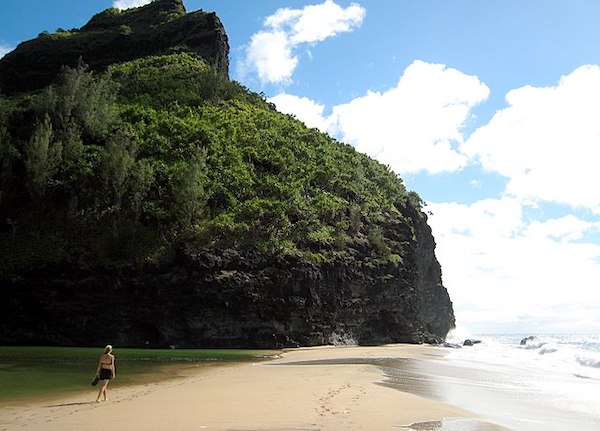 trukdotcom, CC BY-SA 3.0, via Wikimedia Commons
trukdotcom, CC BY-SA 3.0, via Wikimedia Commons
About two miles in, you’ll find your second beach, Hanakapi’ai. If you’re just looking for a day hike, you can spend some time on the beach and then hike back. There are composting toilets near the beach.
NOTE: Only those with overnight camping reservations are allowed to hike beyond Hanakapi’ai.
Hanakapai’ai Waterfall
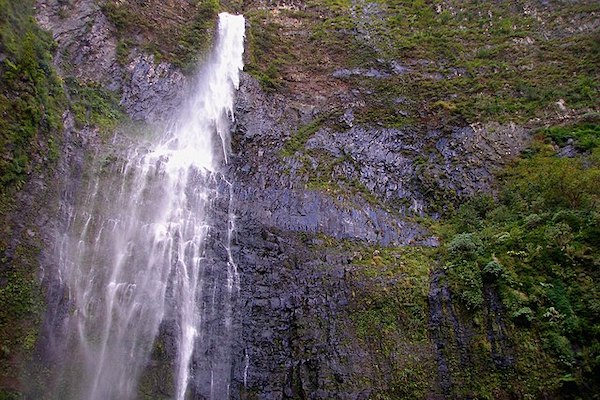 Brian W. Schaller, FAL, via Wikimedia Commons
Brian W. Schaller, FAL, via Wikimedia Commons
You’ll need to decide at this point if you want to add another four miles (round trip) of tough hiking into your adventure to see the Hanakapai’ai Waterfall. Hanakapai’ai Waterfall is an impressive 300-foot falls with an excellent swimming hole, so if you’re up for a challenge, it’s worth the extra mileage. But make sure to bring plenty of water!
The trail to the falls begins just after crossing the Hanakapai’ai Stream, near the vault toilets. There are tricky creek crossings, and the path gets extremely muddy around the end of the hike, so be careful. If it has been raining or rain is in the forecast, there is a serious risk of flash flooding. Check trail conditions before setting out.
NOTE: Only those with overnight camping reservations are allowed to hike beyond Hanakapi’ai.
Hanakoa Campground and Hanakoa Falls
 J Doll, CC BY-SA 3.0, via Wikimedia Commons
J Doll, CC BY-SA 3.0, via Wikimedia Commons
The first campsite along the trail is located in the Hanakoa Valley about three miles past Hanakapai’ai Falls. This is the first of two locations you are allowed to camp along the Kalalau Trail, which features a nearby waterfall and beautiful views of the surrounding landscape.
There are composting vault-style toilets available, but no other facilities such as potable (drinking) water, pavilions, or tables. There are freshwater streams nearby for gathering water to filter and drink.
Crawlers Ledge
If you’re continuing on to Kalalau Beach, you’ll first have to cross the infamous Crawler’s Ledge. You’ve probably gathered this from the name, but Crawler’s Ledge is an extremely thin, sloped stretch of path overlooking a long, steep drop into the rocks and ocean below. It’s the most dangerous section of the trail, and you’ll need to be extremely careful to ensure your safety. Take your time and know your limits!
Kalalau Valley and Kalalau Beach
 Kalalau Valley
Kalalau Valley
A few more miles and you’ll find yourself overlooking the Kalalau Valley, and a few miles after that you will arrive at your final destination: Kalalau Beach. Here, you’ll camp surrounded by jagged green ridges of the Na Pali Coast, a lovely stream, and the beautiful Ho’ole’a waterfall.
There are composting vault toilets available, but no other facilities. Be sure to bring a filtration system to treat water from the nearby stream.
Kalalau Lookout
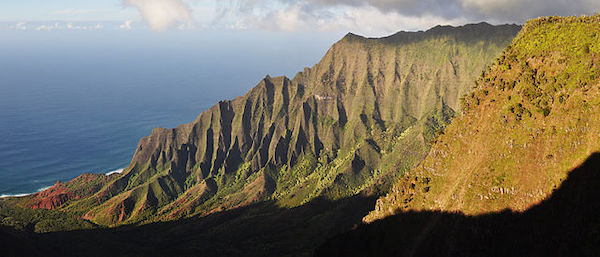 By Paxson Woelber, CC BY-SA 3.0, via Wikimedia Commons
By Paxson Woelber, CC BY-SA 3.0, via Wikimedia Commons
If you’d like to see the Kalalau Trail and Na Pali coast without hiking 22 miles round trip or booking a boat tour, you can drive right up to the Kalalau Lookout. Keep in mind that you get to the overlook from the other side of the park, which can only be accessed coming from the western side of the island. To find the lookout, take Koke'e Road Highway 550 almost all the way to its end.
The lookout offers a breathtaking view of the Na Pali Coast State Wilderness Park. You can see the entire Kalalau Valley and the dramatic ridges that surround it all the way to the ocean.
Kalalau Weather
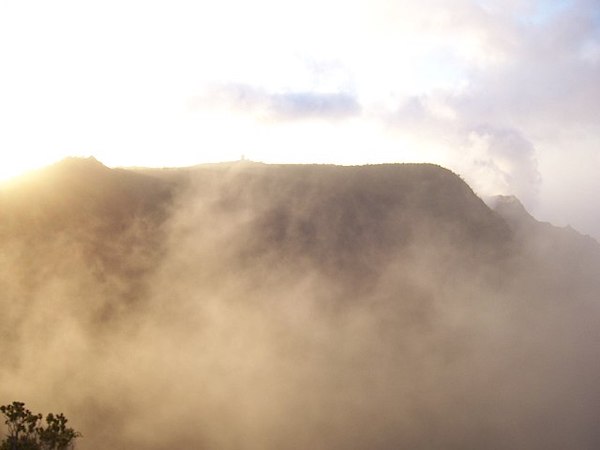 Bryce Edwards from San Jose, CA, USA, CC BY 2.0, via Wikimedia Commons
Bryce Edwards from San Jose, CA, USA, CC BY 2.0, via Wikimedia Commons
Hawaii generally has two seasons: a wet winter and a dry summer. The winter occurs from November to March. Temperatures pick up and precipitation decreases from April to October during the dry season. We recommend the summer season since certain parts of the hike are dangerous, even without rain. Temperatures vary from the mid-70s to the mid-80s.
Kalalau Safety
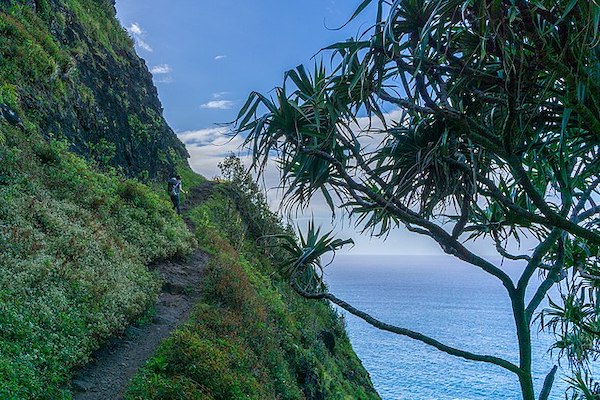 J Doll, CC BY-SA 3.0, via Wikimedia Commons
J Doll, CC BY-SA 3.0, via Wikimedia Commons
Before you start making plans, you should know that the Kalalau Trail is a dangerous adventure. The trail has claimed more than two lives and is responsible for countless serious injuries. Numerous visitors have been stranded due to flash flooding. What’s more, Na Pali is one of the most remote places in all of Hawaii, so if disaster does strike, you’ll probably need a rescue team to get out.
Take the hike slowly, especially along dangerous sections like Crawler’s Ledge. Make sure to pack a water filtration device, since you won’t want to carry in all the water that you’ll need. You should also bring iodine tablets too, in case your filtration system malfunctions. You’ll, of course, want to pack plenty of food, as well.
Hiking boots or trail shoes are highly recommended. You may also want to bring approach shoes (usually used by climbers) for the particularly gradient sections of the trail. Bring a first aid kit that includes necessities like bandages, gauze, and disinfectant.
Although the Kalalau Trail should be taken seriously, as long as you are careful and know your limits, you should be safe. If you choose to undertake this journey, it's definitely a memorable adventure.
Parting Thoughts...
The Na Pali Coast and the Kalalau Trail are truly natural wonders and should be treated as such. Please be respectful of the wildlife and any animals you come across during your journey. Please also show your appreciation for the land by throwing out your trash and leaving the trail better than you found it.
RELATED: Hanalei Travel Guide and 10 Ways to Be a Safe and Responsible Traveler in Hawaii
Visiting Kauai? Shaka Guide has four audio driving tours on the island!












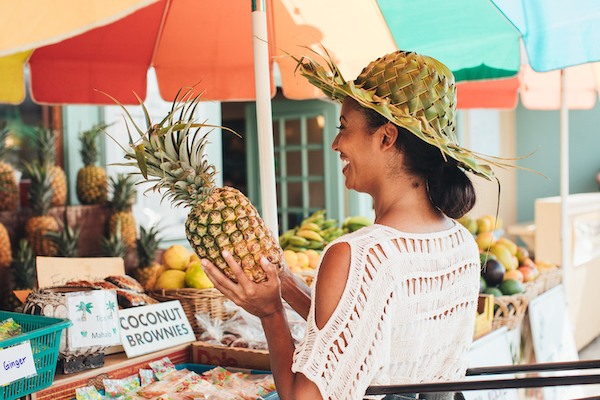












 to fuel your ride
to fuel your ride 
